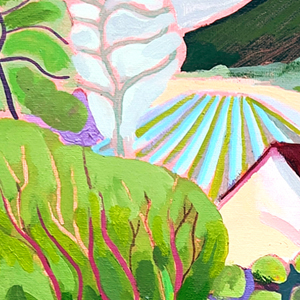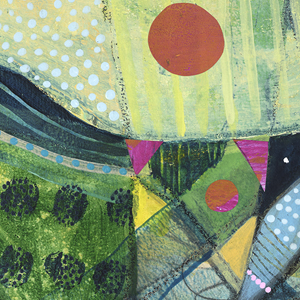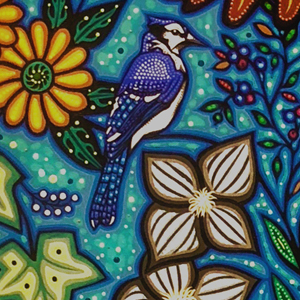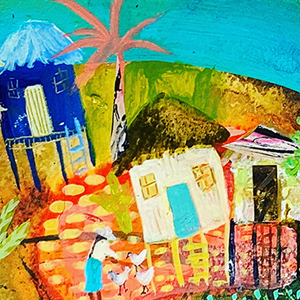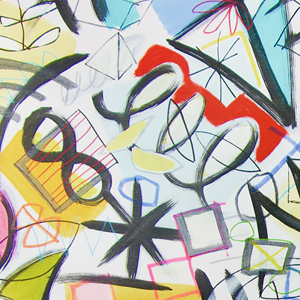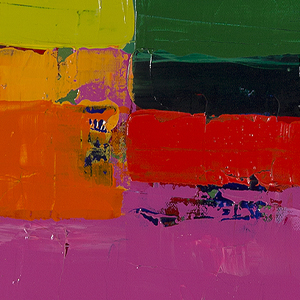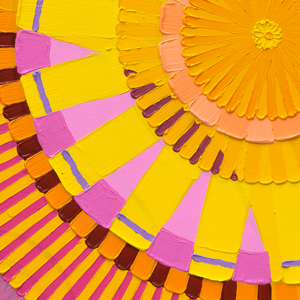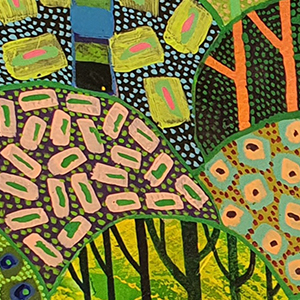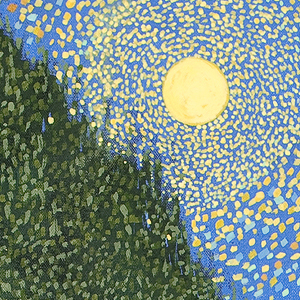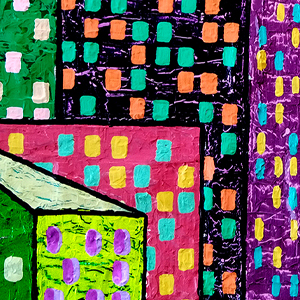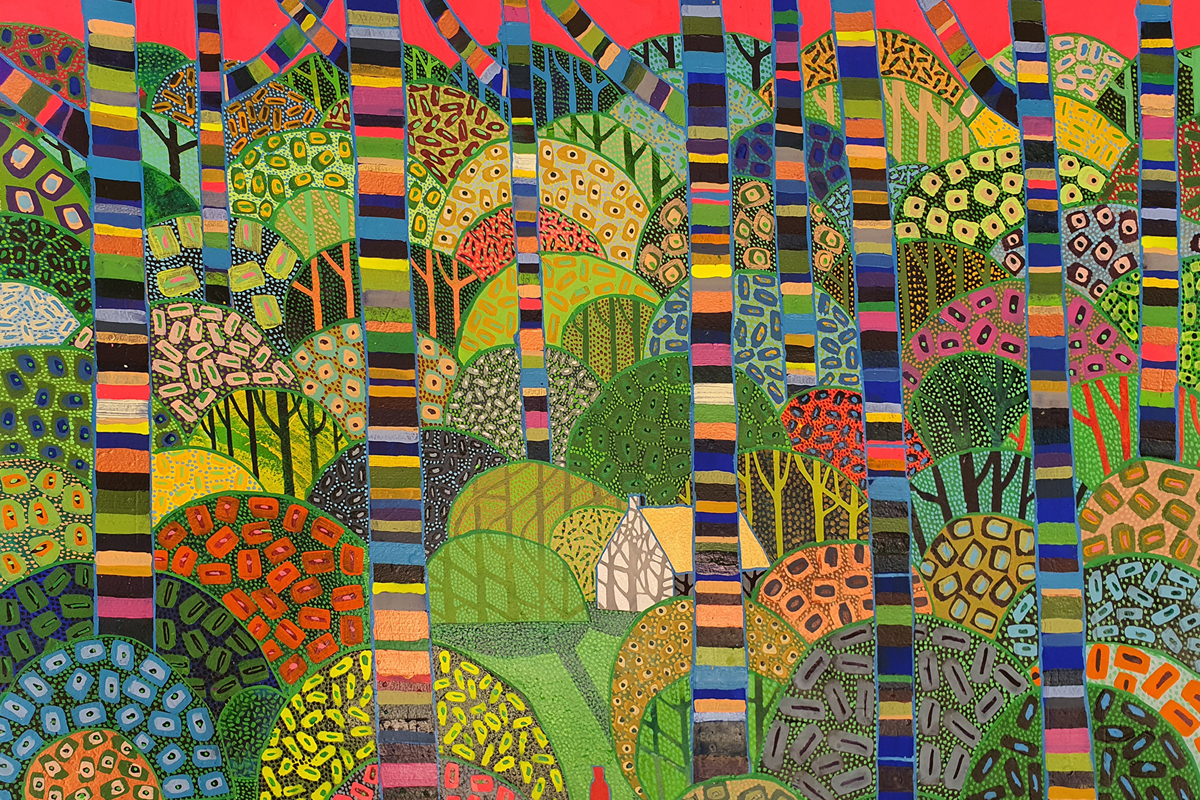
Good Medicine
The Two Josh Problem
Abraham Nussbaum
Artwork: “Oscar’s Tale” by Richard Friend © 2022
My two worlds collided, on the corner of Colfax and Monaco, when the Two Joshes met each other last Saturday at the True Value. Back of the store, one flight up, stairs to the left, a ramp to the right, and into an alternative apprenticeship.
The first Josh was on duty, his soft locs draping either side of his face as he accepted deflated tires from the fair-weather folks who take the bikes out of their garage each spring only to find wheels no longer rolling. The sunny day customers look surprised to find a full repair bicycle shop wedged into the attic of a century-old hardware store. At the top of the stairs, they look right to see the service bay, where a bespectacled middle-aged man moves between four bicycle stands with obscure metal tools in his hands. He gently pulls on aged brakes and chains. He forcefully pushes on frames and cranks. Recoiling from the forces, the visitors usually look away to the left. They see a row of new bicycles, shining from the Pledge rubbed into their frames, under the track lights. They wonder if it might be easier to purchase a new bike. They catch a price tag and look around again, finding, standing before them, a short young man with open arms.
Josh takes the wheel. He listens to their story, whether it is about a sudden loss of pressure or a slow leak of air, while inspecting the wheel. He unscrews the valve, unseats the tire, inspects the rim for damage. He advises a new tube or a new tire or new sealant and offers to install each while the visitor waits. Some walk out over the price. Most accept the fee. Either way, the encounter is over within ten minutes. Josh changes tires quickly, charges people what he said he would charge them, and they pay what they agreed upon. They are ready to ride, with sunny day to spare, unless Brad puts down his tools and walks over from the service bay.
If Brad gets involved, the repairs will prove more complicated and more improvisatory. Brad rarely takes the wheel. He rolls the whole bike up the ramp into the service bay, mounts it in a stand, and powers the wheels forward by the cranks. A brake rubs against a rim. A rusted chain protests over stiff joints. Brad hears the problems. Without words, he starts solving them, aiming to put the bike back on the road within the hour. Only the truly ailing bikes spend the night in the shop.
My bikes take the treatment every couple of weeks. I wheel up one of our family’s bikes to Josh. Once Brad gets interested, I borrow one of his stands and work on a bike until I reach my limits. Then Josh tries. Brad checks our work, never allowing an error to stand. The visit usually turns into an afternoon. Instead of replacing a single cable, we realign the rear derailleur hanger, true the wheels, and wax the chain. Brad teaches new skills freely, never lecturing, never chiding, like a generous teacher.
• • • • • • • • • • • • • • • • • • • •
The other Josh got the Brad treatment last month, nine months after I prescribed a trip to the True Value. Josh is a young doctor, an intern physician who relocated half-way across the country to train in my own specialty. We met on the first day of his orientation. Dr. Josh told me he liked bicycles but had not been riding because his Surly whined when he shifted gears. I gave him directions to the other Josh. He said he would visit the True Value.
A few months later, we worked together in the hospital. In between seeing patients, I asked after his ride. Dr. Josh said his bike was still laid-up because he was too busy to take it to Josh.
The first year of residency is too busy. Graduating medical students often relocate across the country, then move every month between different clinical services, even different hospitals. In each setting, they can work up to eighty hours a week caring for dozens of patients suffering from any of hundreds of illnesses. The year changes a young physician as they become the kind of person who asks personal questions, conducts probing examinations, and performs invasive procedures.
Attending physicians like me supervise interns, correcting their questions, examinations, and procedures. Start the conversation slowly instead of abruptly. Order this test instead of the one a computer suggested. As we do so, supervising physicians orient a resident physician to the rules and cultures of the hospital: when to wake and sleep, eat and fast, work and study.
Many intern physicians find the work more deforming than formative, experiencing their extended hours in the hospital as ceaseless chores rather than constructive clinical encounters. Resident physicians report high rates of an alphabet’s worth of problems beginning with anxiety, burnout, cynicism, and depression.
The name of the hospital for many interns is factory.
• • • • • • • • • • • • • • • • • • • •
The name of the hospital used to be generosity. The public hospital began life as a guesthouse for all the ill, developed in the fourth century by Basil of Caesarea. Basil built his hospital, along with a hospice and poorhouse, on the outskirts of town to welcome travelers. In his lifetime, the healing complex was called the Basileiad.
At his funeral, the Basileiad was hailed as a “new city,” the very place “where disease is regarded in a religious light, and disaster is thought a blessing, and sympathy is put to the test.”
Psychiatrists, like me and Dr. Josh, put our sympathy to test at a contemporary Basileiad, a safety-net hospital. Within our hospital, three units are dedicated to the care of persons with mental illness, an implicit continuation of another pioneer of generosity. In the 14th century, Joan-Gilabert Jofré, a Spanish priest, founded the first psychiatric hospital in western society. The Hospital of the Innocents sheltered people with serious mental illness because then, as now, they were often marginalized from society.
The shape of the public hospital, from Basil to Jofré and beyond, embodied a community’s desire to share its gifts with the indigent ill without obligation. The services of the public hospital were largely free, not offerings in expectation that acclaim or wealth would accrue to its giver. The practitioner in the public hospital learned the right way to give their skill away. In Aristotle’s formulation, when you give too much away, you are wasteful. Give too little away, and you are covetous. Give the right amount away, and you are generous.
The services in today’s hospitals are often more technically advanced than those offered by Basil and Jofré, but often simultaneously wasteful and covetous. It is our problem: some hospitals are still animated by generosity, but many others charge the highest prices the market will bear. They offer services which are the most remunerative. They sue patients who cannot pay their bills. They limit their community benefit. The result is a country which spends, per capita, twice as much on health care as other high-income countries but has the lowest life expectancy. A covetous system where one in every four dollars Americans spend on healthcare is wasted.
To practice medicine in today’s hospitals, a physician must find the mean of generosity, and pass it along to the next generation as we await a time when generosity will once again animate our hospitals, as it did in the hospitals founded by Basil and Jofré.
• • • • • • • • • • • • • • • • • • • •
Today’s hospitals are often unfavorably compared to repair shops: physicians are paid to do things to you, to upsell you on an invasive treatment, and to treat you as a body to be fixed. Plenty of bike shops also miss the mean of generosity, preferring to upsell you to a new bicycle instead of repairing your current ride or encouraging you to throw away an older bicycle. Like bad physicians, those kinds of shops engage each bicycle as a machine whose every repair must be measured against the possibility of the trash bin out back. The good bike shops attend to the people who bring their bikes.
The best bicycle shops remind us what a teaching hospital can be. Brad and Josh are better at transmitting Basil and Jofré’s virtues than many teaching physicians. In their company, a bicycle repair can be watched, understood, and taught. An education can be given away. If you walk up the stairs.
• • • • • • • • • • • • • • • • • • • •
Dr. Josh finally came to the True Value last Saturday. He came, dressed for a sunny-day ride, in short sleeves and cut-offs. On his left, was a young woman, dressed just as casually. On his right, he wheeled a cob-webbed Surly up the ramp. When Josh met them, Dr. Josh asked for help swapping out his tires. Josh began his inspection. Dr. Josh inquired about how much it would cost to have his shifting fixed as well. At the latter request, Josh sent them over to Brad in the service bay.
I saw them from behind the first stand. I was working on a frame that a sunny-day cyclist had brought in with a flat tire. When Josh told them the cost for fixing the tire, they asked to throw the entire bike away. The frame was a quarter-century old, but handmade out of titanium, so no worse for the passage of time. Brad could not bear to trash the frame, so he acetoned the logos off. I sanded its surface down to the bare metal. Together, we chased its threads, installed a new bottom bracket and headset, and prepared it for another quarter-century of riding.
Dr. Josh saw me cabling the brakes.
“Dr. Nussbaum? You’re here?”
We looked at each other, neither of us in our hospital uniforms. I was in a ballcap, faded blue shorts, color-checked shirt. A look my daughters tells me makes me look more Calico Critter than teaching physician.
I mounted Dr. Josh’s Surly in a stand. I invited Dr. Josh to watch Brad’s examination.
While Dr. Josh explained the shifting problems to Brad, his wife Hannah asked about the wheels. She wanted to set up new tires filled with sealant instead of inner tubes. She worried it would be too complex. I asked if I could pass along some tricks I learned from Brad and Josh.
Hannah nodded. We spent fifteen minutes taking off the old tires, cleaning the rim tape, mounting the new tires and filling them with sealant while Dr. Josh got the Brad experience. A definitive diagnosis. Three possible treatments, each affordable. Dr. Josh’s face brightened; his shoulders relaxed. With Brad’s counsel, he understood what he could do about his bicycle’s problems. As he mulled over the solutions, Josh interrupted. His grandmother and her friend were visiting the shop to say hello. We fist-bumped to avoid greasy handshakes. In exchange, we got stories of Josh’s childhood. We heard how Brad hired Josh for his first job, was teaching him ever more-complicated repairs, and how he swore off Coca-Cola after Brad showed him how soda could strip rust from old parts. Then the older women talked about the public hospital where Dr. Josh and I work. They reminisced about receiving good care at a fair price, but lamented the costs were never posted as clearly as the sign above Brad’s service bay.
After they left, Dr. Josh pulled me aside.
“I see why you come. You learn. You fix things. People thank you. Why can’t the hospital be like this?”
We commiserated about how hospital teaching was typically the dispatch of efficiency instead of the communication of love for our craft. He asked if we could meet outside the hospital some time and chat about how the hospital could be more like the True Value. I agreed.
• • • • • • • • • • • • • • • • • • • •
The problem Dr. Josh and I could fix at the True Value was the repair of his bicycle. The problem we began to fix that day is why it was easier for me to have a teaching relationship with Dr. Josh in a bicycle shop than a teaching hospital.
In the hospital, I have long shared a quote with trainees. In a letter, Simone Weil wrote that attention is the rarest and purest form of generosity. I tell young physicians that this is especially true in my specialty. In psychiatry, we have no cures. This can be a curse since we cannot lift illness entirely off someone. This can be an opportunity because we can always attend to each other generously.
These days, I tell every young doctor to visit the True Value. Get an education in generosity like I did. Chat with Josh and Brad too. Accept their invitation back to the service bay.
Perhaps they will find, as I did, that invitations to the bay became offers of bicycles discarded by sunny-day riders. You can take a discarded a bicycle, a perfect little machine, and get it rolling again. Once I asked Brad if he ever thought to sell those discarded bikes. He shook his head, muttered something about how he could not charge for what he had received for free because it was a step towards becoming a chop shop. Then he returned to his stand, to another bicycle, and to generously teaching me and every Josh who walked up the stairs.
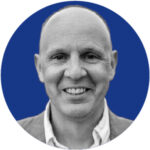 Abraham Nussbaum, MD, is a physician, writer, and cyclist in Denver, Colorado. His most recent book, Progress Notes: One Year in the Future of Medicine, was published with Johns Hopkins University Press in the summer of 2024.
Abraham Nussbaum, MD, is a physician, writer, and cyclist in Denver, Colorado. His most recent book, Progress Notes: One Year in the Future of Medicine, was published with Johns Hopkins University Press in the summer of 2024.
Fall 2024
Part I: Abundant Virtue
Laurie L. Patton
Sarah A. Schnitker
Patricia Snell Herzog
Melissa Fitzpatrick
Dirk Philipsen
Interlude: Generous Eyes, Radical Love
Fr. Martin Lam Nguyen, CSC
Part II: Abundant Vocation
MORE





